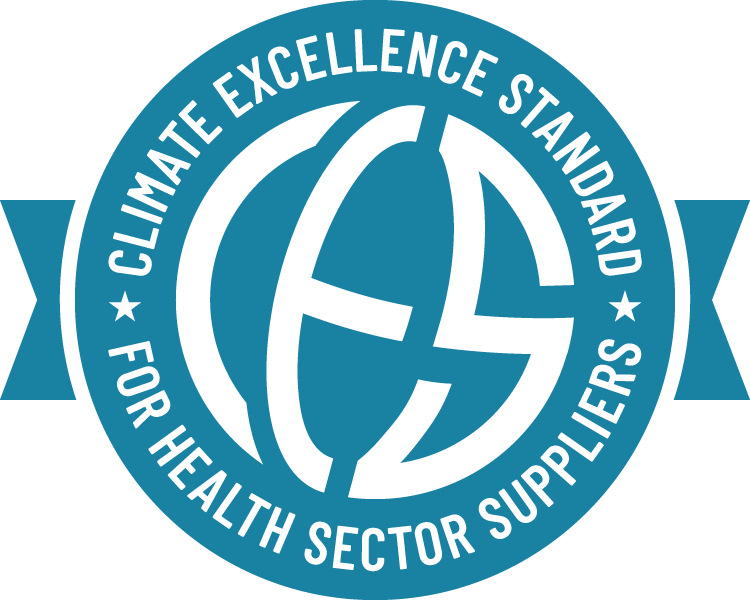The Climate Excellence Standard for health sector suppliers defines superior performance in decarbonization on the part of individual suppliers – including manufacturers and distributors – to ensure the health care supply chain is aligned with achieving net-zero emissions by 2050, while improving resilience. Reducing the health care sector’s reliance on fossil fuels is critical for reducing deaths and diseases related to greenhouse gas emissions, and the time is now for deep engagement across the supply chain.
Purpose and use:

Use of the standard will include showcasing suppliers that attain climate excellence status, giving them visibility at events and publications, and highlighting the collaborations that make advancements possible. By featuring successes by health care leaders, we will accelerate momentum to decarbonize the sector, ultimately influencing the broader economy.
Health systems and their group purchasing organizations may embed some or all of the requirements into requests for information, requests for proposals, or contracts so product or supplier selection is informed by emissions performance.
Supplier performance will be verifiable through publicly accessible websites.
This standard will be updated periodically to align with rapidly evolving developments in supply chain decarbonization, ensuring that it continues to define the standard for excellence.
Requirements of the Climate Excellence Standard
Phase 1 (2023-2025):
- Emissions target and plan has been submitted to the Science Based Targets Initiative (SBTi) for approval, or the company has an SBTi-approved plan with near-term or long-term targets, OR
- Publicly commit to a near-term or long-term science-based emissions reduction target as defined by SBTi, and
- Measure Scopes 1, 2, and 3 emissions using the Greenhouse Gas Protocol, and
- Disclose emissions through CDP, EcoVadis, or similar publicly accessible and recognized platforms (disclosures only on suppliers’ corporate websites do not meet this criteria), and
- Assure Scopes 1 and 2 emissions data through a third-party verifier.
AND
- Minimize use of carbon offsets to only those emissions that currently do not have a realistic, practical solution. Applicable through 2025 only.
- Prepare and execute a publicly available plan to reduce operational emissions (Scopes 1 and 2) and the most relevant Scope 3 categories (e.g., emissions from staff commuting, waste, and business travel).
- Incentivize major vendors or subcontractors that reflect at least 20% of spend to commit to a science-based target along with the other requirements described in this section.
Phase 2 (effective in 2026):
The standard will be revisited in collaboration with suppliers and health systems to consider and further develop these and other provisions to be effective in 2026.
- Continue to meet the requirements of Phase 1, and
- Provide the date when the supplier will have a publicly available SBTi-aligned plan to limit the use of offsets to residual emissions (not to exceed 10%).
- Provide emission factors associated with the company’s top-selling products representing 20% of revenue within each business unit by 2028.
- Reduce single-use fossil fuel plastics in health care by offering sustainable, non-toxic products that are part of a circular system keeping materials in use while regenerating natural systems.
- Prepare, execute, and make publicly available resilience plans with climate and environmental considerations. Plans should build in considerations to produce and deliver products with minimal disruption due to man-made or natural disasters. Incorporate climate resilience tactics into annual strategic decision-making, policies, pay bonuses, and the organization’s mission statement.
- Reduce transportation emissions across the supply chain through solutions including electric fleets, optimized logistics, and partnering with purchasers to reduce trips.
- Publicly release an annual disclosure of all major actions taken by your organization to create a sustainable, closed-loop, and climate-resilient supply chain.
The U.S. Health Care Climate Council established this standard to use its considerable purchasing power to signal to the market the need for significant progress in addressing the severe human health consequences of climate change. By acting collectively, the Council can achieve greater visibility for targeted actions to address supply chain opportunities, while committing to collaborate with suppliers to accelerate decarbonization. By decarbonizing, suppliers enhance their operational resilience and competitive advantage. Practice Greenhealth encourages all health systems to engage with their vendors to see if they meet the Phase I criteria of Climate Excellence Standard or if they plan to meet the standard in the near future.
Suppliers self-assess their performance against the standard, and are responsible for ensuring their claims can be substantiated. To assist suppliers in determining if they have met the standard’s criteria, we have created a self-assessment form. This interactive PDF can be completed online, with a desktop PDF reader, or downloaded for later use.
Note: Since the standard is a tool for measurement, modeling, and evaluation—not a certification, seal, or badge—there is no formal, third-party credentialing process.
The following companies have met the Phase 1 requirements:




Completed the standard and ready to showcase your acheivement?
Suppliers that meet the Climate Excellence Standard (CES) may use the CES logo. The logo may be used wherever the supplier wishes to convey this achievement like social media, website, communications, etc. To obtain the logo, please fill out our simple form and you will be given access.
Climate Excellence Standard for health care suppliers FAQ
How was the standard created?
The standard was established by the U.S. Health Care Climate Council as part of its aim to reduce greenhouse gas (GHG) emissions within health care supply chains. Over the course of one year, the 20 largest medtech suppliers to the health systems that comprise the council provided valuable input through surveys, interviews, and three roundtables. Once the standard was finalized by the council, it was published in Q4 2023.
How is achievement of the standard assessed?
Suppliers self-assess their performance against the standard. A one-page assessment tool is available on the website. Since the standard is a tool for measurement, modeling, and evaluation—not a certification, seal, or badge—there is no formal, third-party credentialing process.
Is there a certification or verification process to validate supplier claims?
No. Suppliers determine their own performance and are responsible for ensuring their claims can be substantiated. Customers are encouraged to request proof of claims during sourcing and contract negotiations.
Health Care Without Harm and Practice Greenhealth do not provide endorsements or verifications of supplier claims.
Is there a fee associated with the standard?
No. The self-assessment tool is available on the Practice Greenhealth website at no cost to suppliers, health systems, or other entities.
My company meets the standard. How can we promote this achievement?
Any supplier is welcome to communicate their achievement of the Standard in their internal and external communications.
We appreciate receiving copies of suppliers’ assessments for use in helping other suppliers improve their performance. Please email [email protected] if you’d like to share a copy of your assessment.
Suppliers that meet the Climate Excellence Standard (CES) may use the CES logo. The logo may be used wherever the supplier wishes to convey this achievement like social media, website, communications, etc. To obtain the logo, please fill out our simple form and you will be given access.
Suppliers may not use the Practice Greenhealth or Health Care Without Harm logos at any time. The CES logo was created specifically for this purpose and to help build momentum in reducing GHG emissions.
Health Care Without Harm and Practice Greenhealth reviewed assessments of a small cohort of suppliers who engaged in the development of the standard and showcased members of that cohort who met the standard.
Why does the standard reference the Science Based Targets Initiative?
Science Based Targets Initiative (SBTi) defines near-term and long-term GHG emissions reduction targets, and SBTi methodology is widely referenced in determining how much and how quickly companies need to reduce their GHG emissions to align with science and prevent the worst effects of climate change.
Why does the standard reference Greenhouse Gas Protocol?
The Greenhouse Gas Protocol provides the recognized global framework to measure and manage GHG emissions.
Why is the standard limited to environmental sustainability considerations?
The standard is a benchmark for climate excellence. Health Care Without Harm and Practice Greenhealth recognize the importance of values-based purchasing, which includes advancing local and community-based economies, environmental sustainability, a valued workforce, community health and nutrition, and other considerations. While all of these aspects are critical for healthy, sustainable, and equitable procurement, the Climate Excellence Standard was created solely to address GHG emissions considerations. Suppliers are encouraged to leverage additional guidance in tandem with the standard to ensure holistic, values-based procurement practices.
How are health systems using the standard?
Supply chain emissions account for half of a typical U.S. hospital’s total greenhouse gas emissions, so incorporating emissions reduction into procurement processes is essential for organizations committed to achieving net zero goals. Health systems are adopting language from the standard in their Requests for Proposals (RFP’s), Requests for Information (RFI’s) and contracts so product and supplier selection is informed by suppliers’ emissions performance.
How does the standard align with other industry efforts that establish criteria for sustainable supply chains?
This standard defines the high bar of performance that suppliers should strive to achieve. It complements standards that set strong criteria for health sector suppliers to achieve. Health Care Without Harm and Practice Greenhealth will continue to push the bar higher and showcase exemplars while being directionally aligned with related efforts to reduce supply chain emissions.
Will suppliers have to conduct another self-assessment when Phase 2 takes effect in 2026?
Yes. The current provisions are in effect through 2025. Starting in 2026, the standard will include all of the criteria in Phase 1, plus additional criteria. Suppliers who claim to meet the standard before 2026 will have to re-assess their performance against the new criteria in order to continue to claim excellence per the standard.
Where can I go for additional information?
If you are a supplier that has one or more health system customers who are members of the U.S. Health Care Climate Council, you may engage with them regarding your performance. Other information can be found here which will be updated as additional resources are added.
If you are a supplier, health system, or other health care entity interested in advancing your sustainability efforts, contact us at [email protected]. We would love to work with you.
Some health systems are signatories to the Impact Purchasing Commitment (IPC), how does this standard align with it?
The Impact Purchasing Commitment (IPC) does have some decarbonization goals, but they are principally focused on the health systems’ own Scope 1 and 2 emissions. When Phase 2 of the CES launches, it may align much more closely with some of the product-level goals in the IPC.
Can I pursue both the CES and Greenhealth Approved?
Yes. However, these are two distinct initiatives that provide purchasers with different types of information. Unlike the Climate Excellence Standard, Greenhealth Approved is not a self-assessment. The Greenhealth Approved seal indicates a product has been reviewed against a set of sustainability criteria specifically developed for eligible product categories--currently furnishings, carpeting, flooring, gloves, and medical devices. More information about the Greenhealth Approved application and vetting process for eligible products can be found on the website.
